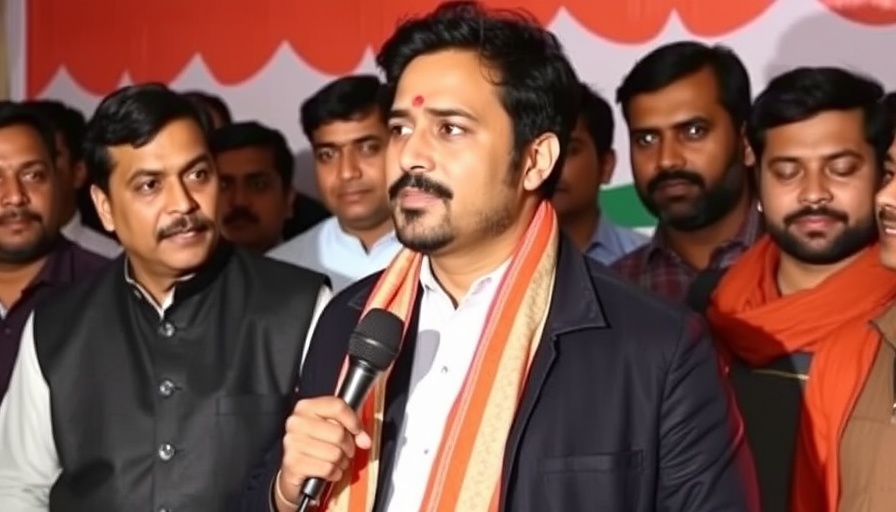
A Deep Dive into the Resignation of Anmol Gagan Mann
In a surprising twist for the Aam Aadmi Party (AAP), Anmol Gagan Mann's recent resignation has sparked widespread speculation and concern among political and business circles alike. As the head of AAP's Punjab unit, Mann played a vital role in cementing the party's position within the state. His sudden departure raises pressing questions about the internal dynamics of the AAP and the broader implications for its leadership integrity.
Crisis of Credibility: The Political Landscape Shift
The political fallout following Mann's resignation extends beyond simple personnel changes. It signals a potential credibility crisis for AAP's leadership. The unexpected nature of this development invites scrutiny; as business executives and leaders, understanding the intricacies of this crisis may offer key insights into navigating similar challenges in organizational settings. With deep ties to grassroots politics, Mann's exit can be viewed as an indicator of larger structural issues within the party that may influence its governance in Punjab.
What This Means for AAP's Future and Governance
For a party that has championed transparency and accountability, this moment presents a governance challenge. The AAP must address internal grievances to restore faith among constituents and party members. The parallel can be drawn to corporate leadership: organizations facing internal strife risk losing credibility with their stakeholders if they do not act decisively. AAP's response in this situation is critical not only for their political prospects but also for reinforcing their standing as a viable alternative for governance in Punjab.
Industry Insights: Navigating Leadership Crises
Leadership crises can emerge from various unexpected events, and organizations must prepare to respond effectively. One actionable insight from Mann's situation is the importance of robust internal communication. In businesses, fostering a culture of openness where concerns can be shared without fear of retribution is crucial. This approach not only strengthens employee morale but also fortifies the leadership's credibility during turbulent times. The AAP may need to consider implementing strategic communication measures to reassure their constituents and themselves.
Lessons from History: Previous Political Resignations
Political history is rich with instances where leaders' unexpected resignations precipitated broader systemic changes. Drawing parallels, events such as the resignation of other prominent political figures reflect how upheaval can catalyze significant shifts within organizations. For instance, when renowned corporate heads stepped down amid scandal, their companies often restructured, refocused on core values, and enhanced governance practices. Such strategic pivots can also be beneficial for political entities like AAP to recapture public trust.
Local Perspectives Towards AAP's Trajectory
From local insights, AAP's trajectory hinges not just on internal leadership adjustments but also on public perception. The constituents of Punjab are looking for a party that embodies their aspirations and delivers on promises while steering clear of controversy. With heightened scrutiny towards political representatives, AAP must work not only to mend its leadership but actively engage stakeholders through transparent dialogue and actionable outcomes.
Business Leaders' Role in Shaping Political Discourse
Business leaders often shape political discourse as they hold significant influence over economic trends and consumer confidence. Understanding the impact political choices have on business ecosystems equips executives to engage more meaningfully in political matters. Observations from Anmol Gagan Mann's resignation can lead to discussions on how corporations and political entities can collaborate for mutual benefit. Leaders can utilize their platforms to advocate for greater transparency and accountability, therefore fostering a cooperative political landscape.
Addressing Leadership Challenges: Strategic Recommendations
Moving forward, AAP must develop a strategic plan to address the elements that led to Anmol Gagan Mann's resignation. Conducting a thorough analysis of the internal culture, gathering feedback from party members, and ensuring that future leaders rise through a competency-based framework are just a few actionable steps. This proactive approach could help rebuild credibility, demonstrating a commitment to both governance and ethical leadership—lessons relevant not only in politics but in every organization.
In conclusion, the political intrigue surrounding AAP and Anmol Gagan Mann's resignation serves as a reminder of the complexities of leadership in both political and corporate contexts. As we observe how AAP navigates this crisis, business leaders can glean insights that directly reflect their own governance challenges, reinforcing the shared necessity for integrity, communication, and strategic engagement.
 Add Row
Add Row  Add
Add 




Write A Comment